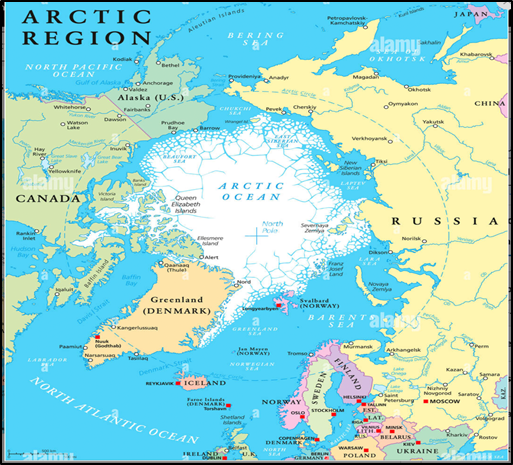In News:
- Researchers of Finnish Meteorological Institute published their study in the Communications Earth & Environment journal.
- The study concluded that the Arctic is heating four times faster than the rest of the planet.
- Other studies in 2021 (the American Geophysical Union) and in 2022 (Geophysical Research Letters) indicate that the Arctic amplification is four times the global rate.
What’s in today’s article:
- Arctic Amplification (Meaning, Mechanism, Causes, Impact, w.r.t. India)
Arctic Amplification

- Arctic amplification is the increasingly ramped-up warming that’s taking place in the area of the world north of 67 degrees N latitude.
- For more than four decades, temperatures in the Arctic have risen at two to three times the pace of the rest of the world.
- High temperatures are melting snow covers and glaciers. Permafrost is thawing and collapsing. Sea ice is disappearing.
- Permafrost is any ground that remains completely frozen—32°F (0°C) or colder—for at least two years straight.
- Some or all of these effects of heat trigger further temperature increases. Effect becomes cause, which becomes larger effect, which becomes stronger cause.
- Arctic amplification is an accelerating feedback loop that accelerates climate change throughout the rest of the world.
Mechanism of Arctic Amplification:
- How Arctic Amplification starts
- Greenhouse gases like carbon dioxide (CO2) and methane (CH4) allow the Sun’s warming rays in through the atmosphere.
- A warmed Earth radiates heat back toward space. However, CO2 allows only about half of the heat energy radiating skyward from Earth to escape the atmosphere.
- Together with the Sun’s rays, heat trapped by greenhouse gases further warms polar air and thaws significant areas of the Arctic.
- It decreases the amount of sea ice, which causes more warming. Which decreases even more sea ice.
- Melting of sea ice has been found to be the single factor most responsible for the accelerating pace of Arctic warming.
- Thawing Permafrost also contributes to Arctic Amplification
- Permafrost is frozen ground that is composed largely of decayed plants. It is full of carbon because, as part of the photosynthesis process, living plants continuously extract CO2 from the air.
- Scientists once thought that the carbon in permafrost binds tightly with iron and is therefore safely sequestered from the atmosphere.
- However, in a study published in a journal demonstrated that iron doesn’t permanently trap CO2.
- This is because, as permafrost melts, bacteria frozen inside the soil activate. They use the iron as a food source. When they consume it, once-captive carbon is released.
- In a process called photomineralization, sunlight oxidizes the released carbon into CO2.
- Wildfires and Arctic Amplification –
- As temperatures rise and permafrost thaws and dries out, grasslands become tinderboxes.
- When they burn, the CO2 and CH4 in the vegetation combust. Airborne in smoke, they add to the atmosphere greenhouse gas load.
Impact on India:
- A study found that the reduced sea ice in the Barents-Kara Sea region can lead to extreme rainfall events in India, in the latter half of the monsoons — in September and October.
- The study was titled - ‘A possible relation between Arctic Sea ice and late season Indian Summer Monsoon Rainfall extremes’ (2021)
- The changes in the atmospheric circulation due to diminishing sea ice combined with the warm temperatures in the Arabian Sea contribute to enhanced moisture and drive extreme rainfall events.
- According to the World Meteorological Organization’s report, ‘State of Global Climate in 2021’, sea level along the Indian coast is rising faster than the global average rate.
- One of the primary reasons for this rise is the melting of sea ice in the polar regions, especially the Arctic.









